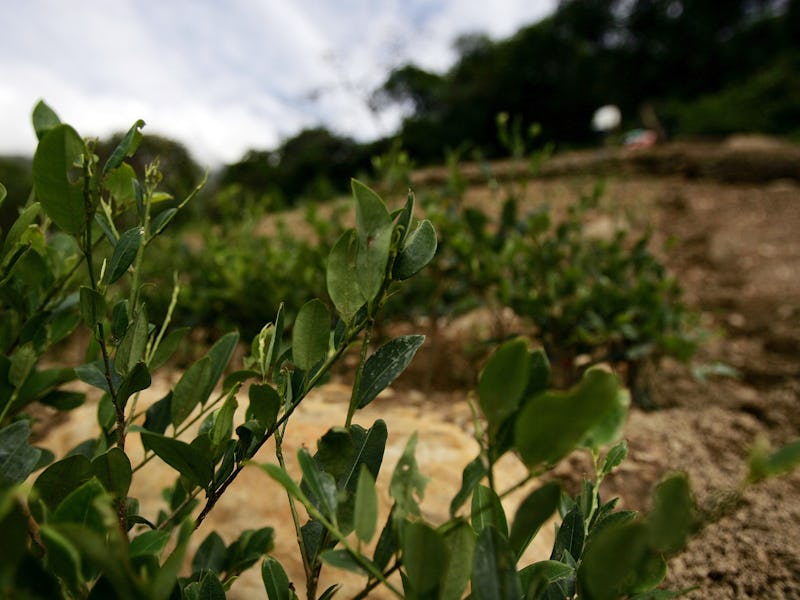Why Is Coca Leaf Left Out of the Drug Research Renaissance?
Years of bad science have blurred the line between plant and drug.

While marijuana, magic mushrooms, and ayahuasca have all found their way into research labs, coca leaf, the mother of cocaine, seems to be off-limits, despite evidence that the plant is a nutritional powerhouse and potential wellspring of medical cures.
This should come as a surprise to no one, says Pien Metaal, a researcher at the Transnational Institute, an Amsterdam-based think tank that advocates for drug policy reform. Policymakers purging the world of its vices, after all, have always been exceptionally thorough — often unnecessarily so.
“In theory, coca would be eligible for medical uses,” Metaal tells Inverse. “But it has never been seriously recognized because of the stigma it has, caused by its content of the alkaloid cocaine.” Obviously, cocaine the drug is a very legitimate public ill, causing some 5,500 deaths in the U.S. each year and thousands more wherever it’s trafficked and produced. But there are no such statistics to justify the demonization of coca leaf, Metaal points out. In fact, there never were.
Bolivian President Evo Morales has been campaigning to reverse the international decree against coca leaf since 2009.
What we do know is that coca leaf shows promise: The innocuous-looking bush used to grow wild in the Andean region of South America, where indigenous populations chewed the leaves or steeped them in tea to reap their myriad benefits: mild stimulation, relief from pain, hunger, and thirst, and respite from mountain-induced altitude sickness. These days, it’s widely cultivated, and yes, many of the crops are boiled down to make illegal cocaine.
But the rest of it is used in the same way it’s always been used: As a social lubricant, sacred substance, and, notably, as food. In 1975, a team of intrepid Harvard researchers published a study showing that coca leaf was also a rich source of mineral nutrients and essential oils. But that was the last time the science community dared touch the coca leaf.
Blame a decree by the U.N. in 1961. The Single Convention on Narcotic Drugs, which corralled the international community into cracking down on cocaine use, had made exceptions for the medical and scientific communities to study it, but by equating coca leaf with cocaine the drug, coca went from mystery plant to a solid no-no. “Most countries in the world have ratified and implemented this prohibition regime,” Metaal says, exasperated. “And they make no distinction between coca and cocaine.”
On a recent trip to Bolivia, Pope Francis openly requested coca leaf tea to treat altitude sickness.
Which brings us to the present day, where Googling “coca leaf” pulls up hundreds of goods claiming health benefits ranging from increased “psychosomatic human welfare” to the ability to battle cancer. Uncovering whether there’s any truth to these seemingly miraculous claims would, of course, require scientific inquiry — which, in turn, requires money that wary governments almost always refuse to provide. “In talking to researchers and talking to universities, the main reason is that these studies cost a lot of money, and there’s hardly any money for this subject because of the fact that it’s illegal,” Metaal says. This catch-22 is, of course, not a new theme in the world of illicit drug research, but coca leaf presents a particularly compelling case since there’s barely any evidence to prove it can be abused.
The impossibility of funding is especially maddening because the 1950 U.N. Economic and Social Council report that originally spurred the U.N. to make its edict in 1961 is riddled with inaccuracies and biases that would never fly today. “The report, if you read it, is basically saying that Indians are very lazy, and it inhibits their capacity to eat,” she points out. “This article is basically out of sync with reality and it’s old and it needs to be revised.”
Unfortunately, nations that have tried to reverse the U.N.’s condemnation of the leaf have not been successful. Evo Morales, the President of Bolivia and current chairman of the Group of 77 nations, has been campaigning since 2009 to remove coca leaf from a list of internationally banned drugs, calling the crop an important symbol of Andean indigenous culture; in an open letter in the New York Times published in 2009, he condemned the U.N.’s edict, saying that “the millions of us who maintain the traditional practice of chewing coca have been, according to the convention, criminals who violate international law.” So far, he’s succeeded in convincing all but 17 of the 184 states involved in the original treaty to change their minds, but the policy remains fixed until the decision is unanimous.
Metaal, convinced that interest in exploiting coca leaf’s traditional uses will lead policymakers to change their minds, remains hopeful that the plant will follow the same path as marijuana and ayahuasca. “[We want to] find new evidence and new arguments to show that it doesn’t create a habit, it’s not a danger for health,” she says. She’s not alone in her optimism: Elsewhere in the Andean region, specialty businesses like the Embajada de la Coca in Bogotá have started selling coca leaf products as a health supplement, and even Pope Francis, visiting La Paz, Bolivia, recently requested coca leaf tea to remedy his altitude-induced nausea. To Metaal, the obstacles to coca leaf’s acceptance are as illusory as the dangers they’re imagined to pose. Unfortunately, those obstacles are often the hardest to move.